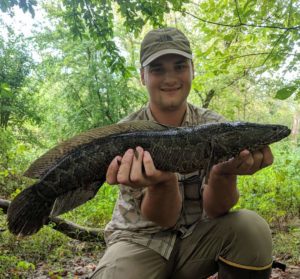September 8, 2020
Help Our Rivers by Catching and Eating Invasive Fish
Invasive species, like Snakehead fish and Blue Catfish out-compete the native species of fish for food and habitat and damages the local food web. Help our rivers by catching and eating invasive fish. Learn some fishing tips below on how to catch these invaders from David Lanier, the Federation’s Restoration Project Manager.

Snakehead fishing
The Snakehead fish, originally from Asia, are now well established throughout Maryland’s rivers. To find them, head to the upper reaches of our creeks where the water is shallow and weedy. A kayak is probably your best bet for getting to the most snakey areas, but there are also ample opportunities for shore fishing along our creeks. A large minnow under a bobber is a sure way to catch Snakehead. If you prefer to fish with lures, you are in luck because a Snakehead will hit just about anything. They are most frequently targeted with topwater lures worked slowly along the edges of vegetation. Chatterbaits, swimbaits, and spinners are also highly effective. Snakehead fishing is rapidly rising in popularity as people are becoming more aware of this delicious, hard-fighting fish. Most tackle shops have caught onto the Snakehead craze, so if you’re starting from scratch head to your local shop. They will be happy to get you set up and may even have some good fishing spots to share with you.
Blue catfish fishing
Another tasty fish invading our waterways is the blue catfish. These Mississippi River natives hang out near the bottom and eat everything they can find down there including fish, crabs, and clams. To target them on our rivers, use a medium rod or heavier set up for bottom fishing. They are easily targeted from shore, a dock, or from a boat. Use 5/0 circle hooks and a few ounces of weight to keep your rig on the bottom. The most effective bait is fresh cut fish or chicken livers, but feel free to try other kinds of fresh bait as blue catfish are not picky. These fish are known for their trophy sizes in their native waters. While they are not reaching monstrous sizes in our rivers yet, don’t be surprised if you run into a 20 or 30 pound fish.